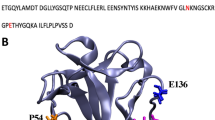Abstract
Recombinant human keratinocyte growth factor (rhKGF) is prone to aggregation at elevated temperatures. Its aggregation pathway is proposed to proceed initially with a conformational change which perhaps results from repulsion between positively charged residues in clusters forming heparin binding sites. Unfolding of the protein leads to formation of large soluble aggregates. These soluble aggregates then form disulfide cross-linked precipitates. Finally these precipitates are converted to scrambled disulfides and/or non-disulfide cross-linked precipitates. Stabilizers such as heparin, sulfated polysaccharides, anionic polymers and citrate can greatly decrease the rate of aggregation of rhKGF at elevated temperatures. These molecules may all act by reducing charge repulsion on the protein thus stabilizing the native conformation. EDTA, on the other hand, is found to inhibit disulfide formation in aggregates and has only a moderate stabilizing effect on rhKGF.
Similar content being viewed by others
REFERENCES
W. H. Burgess, and T. Maciag. The heparin-binding (fibroblast) growth factor family. Annu. Rev. Biochem. 58:575–606 (1989).
J. S. Rubin, H. Osada, P. W. Finch, W. G. Taylor, S. Rudikoff, and S. A. Aaronson. Purification and characterization of a newly identified growth factor specific for epithelial cells. Proc. Natl. Acad. Sci. USA 86:802–806 (1989).
P. W. Finch, J. S. Rubin, T. Miki, D. Ron, and S. A. Aaronson. Human KGF is FGF-related with properties of a paracrine effector of epithelial cell growth. Science 245:752–755 (1989).
D. Ron, D. P. Bottaro, P. W. Finch, D. Morris, J. S. Rubin, and S. A. Aaronson. Expression of biologically active recombinant keratinocyte growth factor structure/function analysis of aminoterminal trancation mutants. J. Biol. Chem. 268:2984–2988 (1993).
D. Gospodarowicz, and J. Cheng. Heparin protects basic and acidic FGF from inactivation. J. of Cellular Physiology 128:475–484 (1986).
T. K. Rosengart, W. V. Johnson, R. Friesel, R. Clark, T. Maciag. Heparin protects heparin-binding growth factor-1 from proteolytic inactivation in vitro. Biochem. and Biophys. Res. Comm. 152:432–440 (1988).
P. K. Tsai, D. B. Volkin, J. M. Dabora, K. C. Thompson, M. W. Bruner, J. O. Gress, B. Matuszewska, M. Koegan, J. V. Bondi, and C. R. Middaugh. Formulation design of acidic fibroblast growth factor. Pharm. Res. 10:649–659 (1993).
T. Kajio, K. Kawahara, and K. Kato. Stabilization of basic fibroblast growth factor with dextran sulfate. FEBS 306:243–246 (1992).
D. B. Volkin, P. K. Tsai, J. M. Dabora, J. O. Gress, C. J. Burke, R. J. Linhardt, and C. R. Middaugh. Physical stabilization of acidic fibroblast growth factor by polyanions. Arch. of Biochem. and Biophys. 300:30–41 (1993).
C. J. Burke, D. B. Volkin, H. Mach, and C. R. Middaugh. Effect of polyanions on the unfolding of acidic fibroblast growth factor. Biochemistry 32:6419–6426 (1993).
S. Ortega, M.-T. Schaeffer, D. Soderman, J. DiSalvo, D. L. Linemeyer, G. Gimenez-Gallego, and K. A. Thomas. Conversion of cysteine to serine residues alters the activity, stability, and heparin dependence of acidic fibroblast growth factor. J. Biol. Chem. 266:5842–5846 (1991).
P. Caccia, G. Nitti, O. Cletini, P. Pucci, M. Ruoppolo, F. Bertolero, B. Valsasina, F. Roletto, C. Cristiani, G. Cauet, P. Sarmientos, A. Malorni, and G. Marino. Stabilization of recombinant human basic fibroblast growth factor by chemical modifications of cysteine residues. Eur. J. Biochem. 204:649–655 (1992).
W. Burnette, V. Mar, W. Cieplak, C. Morris, K. Kaljot, K. Marchitto, R. Sachdev, V. Locht, and J. Keith. Direct expression of bordetella pertussis toxin subunits to high levels in Escherichia coli. Bio/Technol. 6:699–706 (1988).
U. K. Laemmli. Cleavage of structural proteins during the assembly of the head of bacteriophage T4. Nature 227:680–685 (1970).
H. Edelhoch. Spectroscopic determination of tryptophan and tyrosine in proteins. Biochemistry 6:1948–1954 (1967).
J. A. Schellman. Macromolecular binding. Biopolymers 14:999–1018 (1975).
J. A. Schellman. The effect of binding on the melting temperature of biopolymers. Biopolymers 15:999–1000 (1976).
H. Fukada, J. M. Sturtevant, and F. A. Quiocho. Thermodynamics of the binding of L-Arabinose and of D-Galactose to the L-Arabinose-binding protein of Escherichia coli. J. Biol. Chem. 258:13193–13198 (1983).
B.-L. Chen, T. Arakawa, A. Hsu, L. O. Narhi, T. J. Tressel, and S. L. Chien. Strategies to suppress aggregation of recombinant keratinocyte growth factor during liquid formulation development. J. Pharm. Sci. (in press).
W. V. Moore, and P. Leppert. Role of aggregated human growth hormone (hGH) in development of antibodies to hGH. J. Clin. Endocrinol. Metab. 51:691–697 (1980).
C. Rougeot, P. Marchand, F. Dray, J. C. Job, M. Pierson, C. Ponte, P. Rochiccoili, and R. Rappaport. Comparative study of biosynthetic human growth hormone immunogenicity in growth hormone deficient children. Horm. Res. 35:76–81 (1991).
A. Katchalsky, and P. Spitnik. Potentiometric titrations of polymethacrylic acid. J. of Polymer Science 2:432–446 (1947).
Author information
Authors and Affiliations
Rights and permissions
About this article
Cite this article
Chen, Bl., Arakawa, T., Morris, C.F. et al. Aggregation Pathway of Recombinant Human Keratinocyte Growth Factor and Its Stabilization. Pharm Res 11, 1581–1587 (1994). https://doi.org/10.1023/A:1018905720139
Issue Date:
DOI: https://doi.org/10.1023/A:1018905720139




